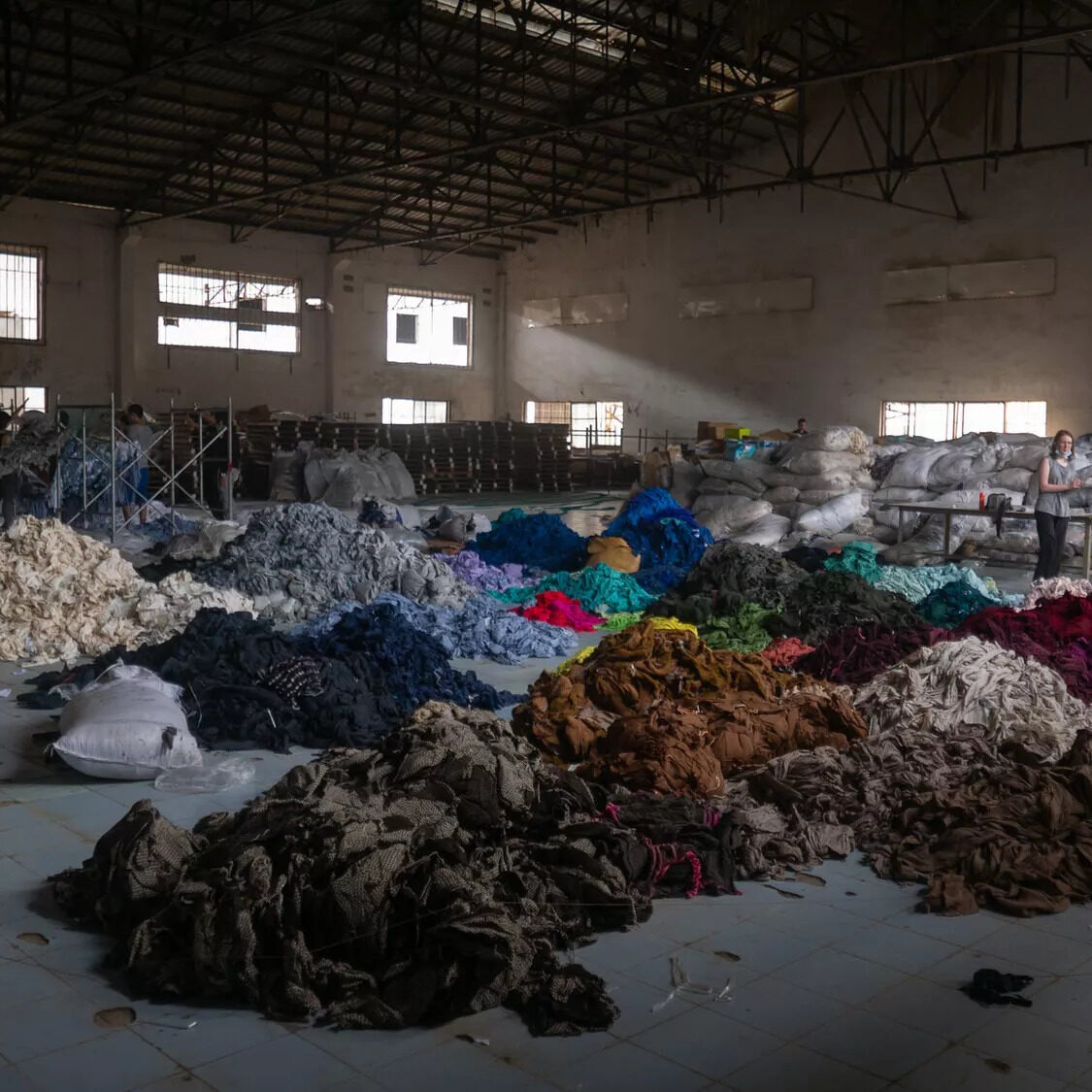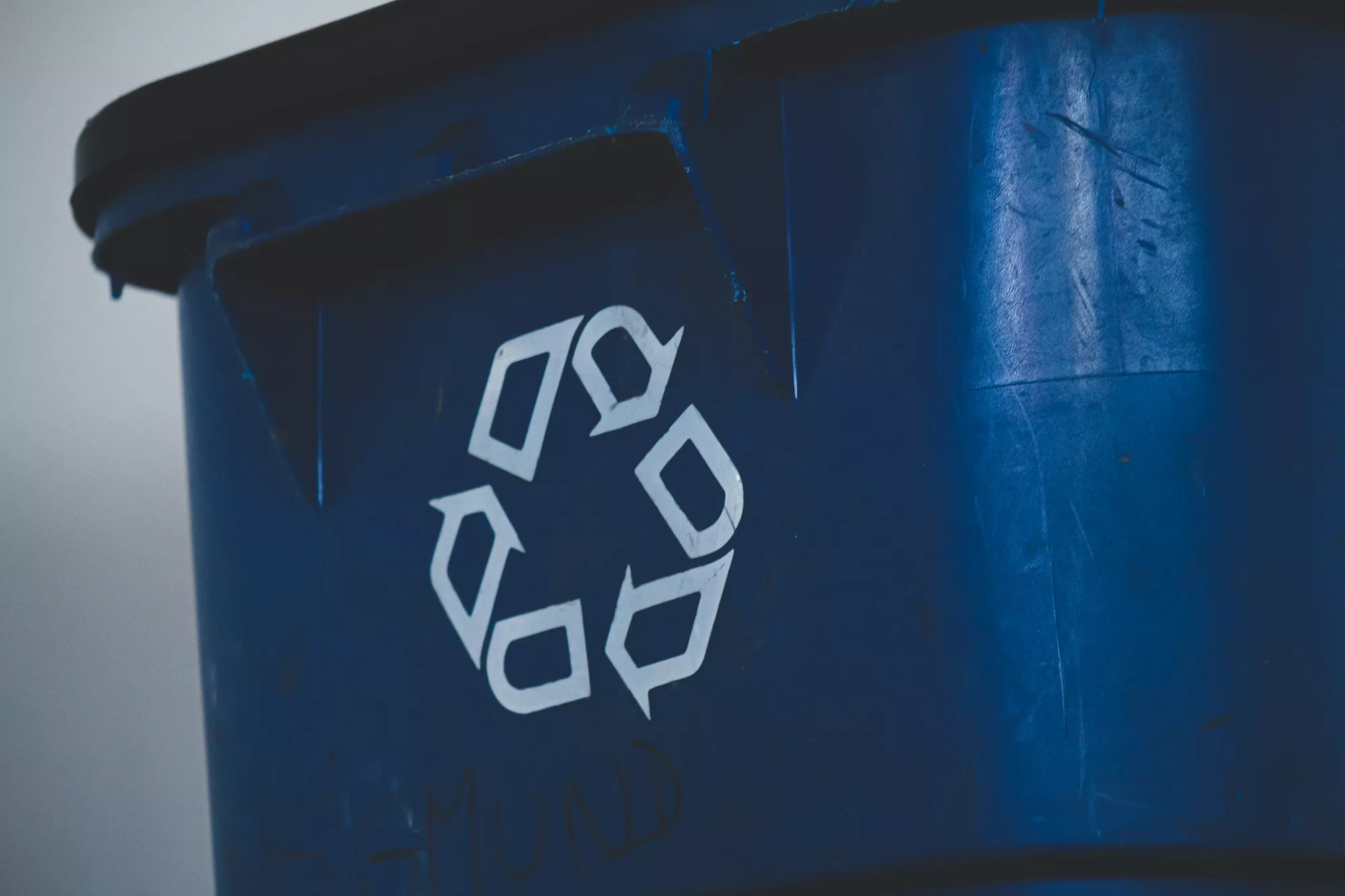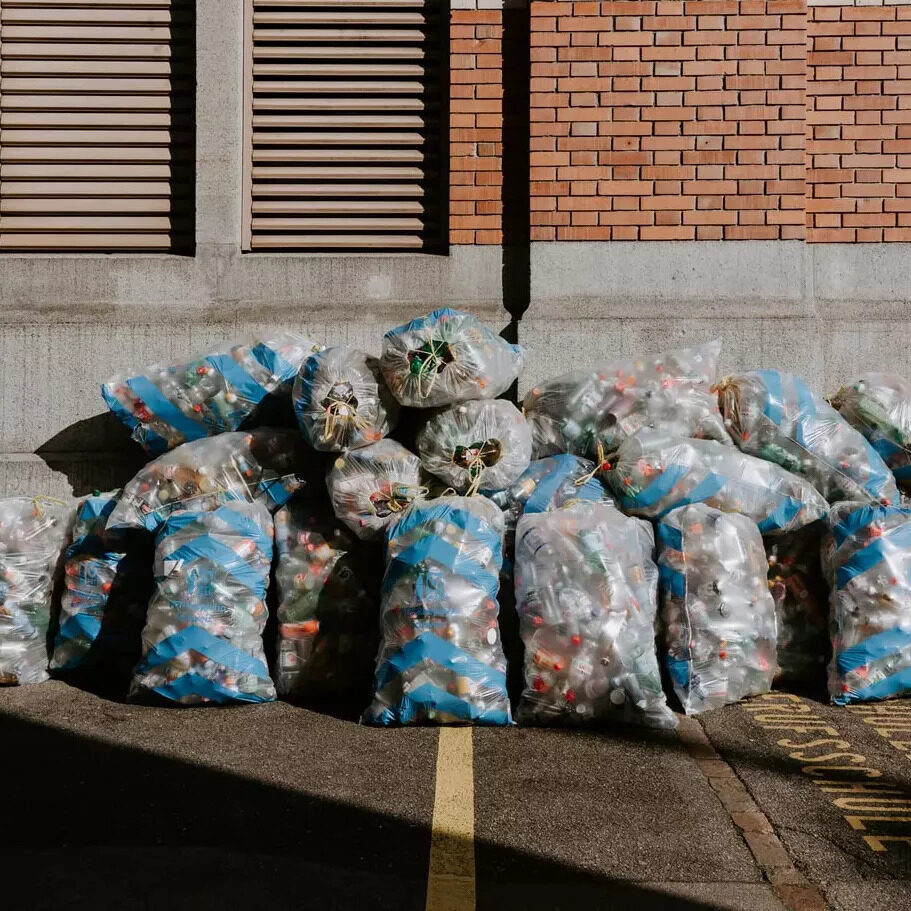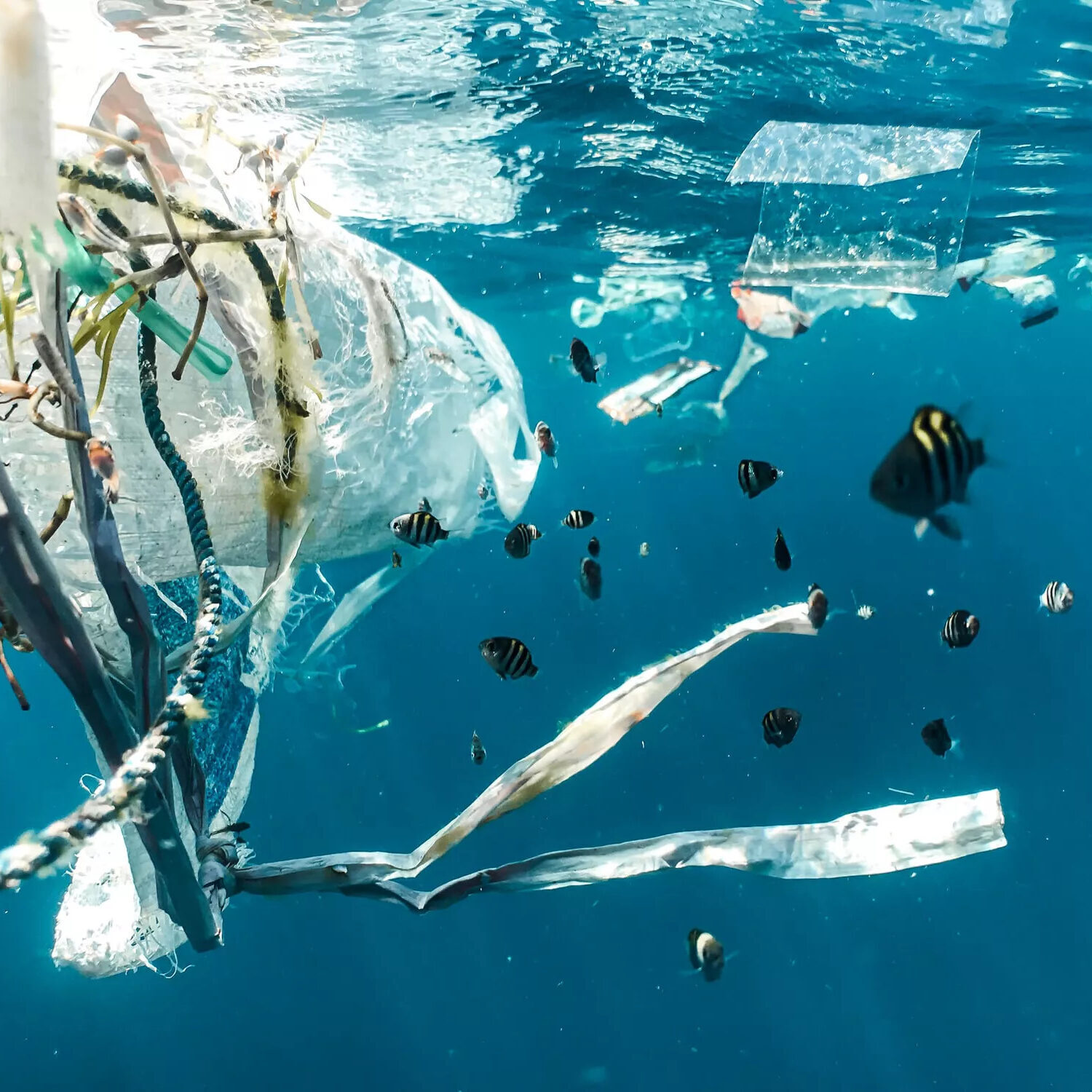
6 November 2025
Sunlight and colour: the hidden drivers of microfiber pollution in the ocean
- Plastics
Plastic is not a fashionable word. So the fashion industry is happy to offer you clothes made from recycled polyester. Virgin polyester is made from fossil petroleum (and is therefore plastic), which has a major environmental impact. Recycled polyester, on the other hand, is usually made from used (post-consumer) PET bottles. Sustainable, right?
Yes, to make rPET or recycled polyester, no new raw materials are sourced. Post-consumer plastic is given a second life in comfy sportswear, sexy bikinis, and colourful blouses – the possibilities are endless!
Recycled polyester’s market share in polyester production in 2020 was 14.7% (Source: Textile Exchange Preferred Fiber and Materials Market Report 2021). This percentage grows year on year as the fashion industry tries to become more sustainable.

The well-oiled fast-fashion machine just can’t seem to grind to a halt. More and more large fashion chains are investing in sustainability and communicating exuberantly.
Recycled polyester is the perfect solution for many brands. It is relatively cheap and available in large quantities compared to other sustainable materials (despite the increase in demand compared to supply). It can also be used for many garments and styles. All clothing that would normally be made of ‘virgin polyester’ can now be made from the recycled alternative.
That makes it an easy way out for the fast fashion industry. A truly sustainable solution would be to produce less and improve the quality of clothes. Producing trendy fashion items in recycled polyester is obviously not a solution. All these “plastic clothes” still have a high chance of having an endless non-biodegradable life on the mountain of textile waste.

Recycled polyester is hot in the fashion industry, especially under the name of recycled PET bottles, which makes it sound like you are doing a good deed when you buy a garment made from this material. However, it turns out that the story is not so rosy. Thanks to greenwashing, correct nuance is hard to find.
Moreover, fibre-to-fibre recycling of polyester clothing is not yet common practice because the techniques and regulations are not in place to support it. Therefore, the recycled polyester (rPET) you see in shops today comes mainly from recycled PET bottles and not from recycled polyester clothing. In fact, according to estimates, 99% of recycled polyester comes from PET bottles (Source: Textile Exchange).
It, therefore, creates an illusion that recycling is flourishing in the clothing industry, when in fact it’s not. Only 1% of all textiles get a second life through recycling (Source: Ellen McArthur Foundation via The Guardian).
A first form of greenwashing with rPET is that fraud is being committed, which means that it’s not always reliable if a brand claims to use recycled PET. A tag might also be attached to a material or garment stating it’s made of recycled polyester, when in reality, only a limited percentage of the garment is made from recycled content (Source: Apparel Insider).
In addition, there is a lack of transparency in the recycling business, making it difficult to trace and verify the actual source of the recycled material. Fortunately, certificates have been established to prove the presence of recycled content: the GRS (Global Recycled Standard) and the RCS (Recycled Claim Standard). Both standards were created by the Textile Exchange to verify recycled content through third-party verification. The GRS goes a step further and also looks at the production process. It wants to reduce the harmful effects of production on people (through social standards) and the environment, guarantee sustainable processing in relation to chemicals and it sets a higher requirement for the percentage of recycled content.
What exactly does such a certificate say about the recycled content? For the GRS, at least 20% of the material must be recycled, and to carry the GRS logo, that percentage must be 50%. The RCS has two different labels, RCS Blended (percentage of recycled content 5%-95%) and RCS 100 (percentage of recycled content 95 – 100%) (Source: Textile Exchange).

Another concern is that PET bottles can be recycled endlessly in their own function (in the food and drink industry). They can, however, no longer be recycled once they have been made into a textile product. Today’s techniques don’t allow for it to be recycled again, when clothes are discarded. It would be more circular, therefore, if the material could be recycled for plastic bottles again and again. In this way, there would be a closed-loop system.

The next problem with recycled polyester is that the textile fibres never biodegrade. They can only break down into smaller and smaller pieces of microplastics in nature.
When the clothes or shoes are worn, movement, abrasion and washing release microplastics into the environment. Recent research even showed that almost 2.3 times as many microplastics would be released from rPET fabric compared to virgin PES (polyester) fabric (Source: İlkan Özkan & Sedat Gündoğdu (2021), due to the fact that its fibres are shorter and more fragile. Because of these short fibres, the garments are also of lower quality, meaning the resulting products will have shorter lifespans.
If you choose a blend of, for example, recycled polyester and virgin polyester or cotton, the amount of microplastics released is somewhat reduced but, of course, still contributes to microplastic pollution (Source: H. Frost, M. C. Zambrano, K. Leonas, J. J. Pawlak, R. A. Venditti, 2022). On the other hand, the disadvantage of mixing two different materials is that it makes recycling more difficult in the end-of-life of the clothes.
This continuous influx of microplastics, along with the mountains of discarded non-biodegradable synthetic clothing, are having a huge impact on aquatic life, the food chain, and animals and humans on earth. Read more about microplastic pollution related to polyester clothing here.
Recycled polyester can be made from various sources. They are usually recycled PET bottles, but also plastic from the oceans, used polyester textiles, or polyester textile residues from production can be valuable raw materials. Recycled polyester producers are spread all over the world but most suppliers are located in India and China.
The recycling of plastics can be done in two ways: mechanically or chemically. According to a quote from Francois Souchet of the Ellen MacArthur Foundation in The Guardian, most recycled polyester for clothing comes from mechanically recycled PET bottles. In mechanical recycling, the material is first broken up into small pieces of plastic which are then melted and spun to make new yarn.
Chemical recycling of polyester is less common because it’s more cost intensive. With this process, the fibres retain their full original quality. The raw materials are broken down, purified, and converted into new particles. By removing all contamination and dyes, these materials can then be recycled in a closed loop. The quality of chemically recycled polyester and its possibilities are thus greater than mechanically recycled polyester. Do you want to know more about clothing recycling? Then read this blog.
Chemically recycled polyester and recycled polyester from textile waste are not yet widely available. Although an enormous amount of resources derived from our discarded clothing are available, recycling them is not yet economically profitable or technically feasible enough for companies.
Experts have different opinions on this. While some scientists conclude that 59% less energy is required than for the production of virgin polyester and that the CO2 emissions during production are 32% lower (Source: WRAP and Swiss Federal Office for the Environment via Fashion United), other studies reveal the opposite result. According to a study by Weiran Qian, Xiang Ji, Pinghua Xu, Laili Wang, published in Textile Research Journal Vol. 91 (2021), the carbon footprint of rPET is about 10x larger than virgin polyester.
Due to the many parameters that influence these results (depending on the production location) and the different scopes used by researchers, it’s hard to come to a direct conclusion. The recycling method also has an influence on how much energy is consumed during production.
Most of the problems of polyester in general cannot be solved by replacing it with recycled polyester. Microplastic pollution, in particular, continues to have a major impact on the environment. But for some garments, it’s difficult to find an equally functional alternative material. These include backpacks, sportswear, (rain) jackets, and swimwear.
According to COSH!, if you’re choosing between clothes made from a natural material, such as linen, hemp, or cotton, and clothes made from recycled polyester in the other, go for the natural option. Why? Because these clothes are more likely to be biodegradable and will not contribute to plastic pollution.
Look for a certificate from GRS, RCS, or whether the supplier is known such as REPREVE® from ocean-bound plastics. With this level of transparency and traceability, you can be as certain as possible that the polyester really is of recycled origin. You can also find out if it has been processed in a responsible way, if it has been produced in safe working conditions and if there’s a chemical policy in force.
Also, pay attention to the quality of the recycled polyester garment and whether there is any visible shedding. If so, it’s definitely better to leave it in the shop!
Fortunately, garments like backpacks and jackets don’t need washing very often. Don’t feel guilty if you choose recycled polyester in this case! It’s important to consider the washing frequency of the polyester garment you buy and the potential risk of microplastics ending up in the environment. Have you got any recycled polyester in your closet that you wear a lot? Take good care of it so it will last as long as possible. You can also use a Guppyfriend to prevent microplastics from spreading during washes, or opt for a laundry machine with a special filter.

6 November 2025

29 October 2025

20 October 2025